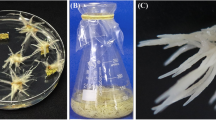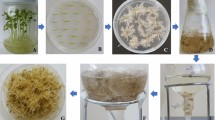Abstract
Fed-batch culture (FBC) is extensively used in microbial culture to achieve a high yield of the desired products. However, the FBC application is less in plant cells or organs because of relatively complex chemical components in the culture medium. To develop the FBC of adventitious roots (ARs) of Oplopanax elatus, the present study designed two FBC systems, where the initial culture media were controlled as 3 L of half- (FBC1) and full-strength (FBC2) of Murashige and Skoog medium, and the culture efficiency was compared with the batch culture (BC). The result showed that AR biomass and bioactive compound accumulation were favorable in both FBC systems compared with those in the BC system. Between FBC1 and FBC2, a significant difference was exerted, with the former showing a good culture efficiency, and 5381.6 mg l−1 of total polysaccharides and 950.8 mg l−1 of total flavonoids were produced in FBC1. In addition, the anti-bacterial property of O. elatus ARs was evaluated for their further using in the production of relative products. The extract from FBC1-cultured ARs (OAE) inhibited growth of bacteria including Escherichia coli, Staphylococcus aureus, Pseudomonas aeruginosa, and Bacillus subtilis, and a higher anti-bacterial effect was found on E. coli. Consequently, the effects of OAE on cell permeability and oxidative respiratory metabolism of E. coli were investigated. The levels of alkaline phosphatase activity, nucleotide or protein leakage, and electrical conductivity in the bacterial substrate were increased by the OAE treatment, illustrating that OAE changed the permeability of cell membranes or walls of E. coli. Simultaneously, OAE inhibited the respiratory of E. coli and a low superposition rate (30.5%) was found in the combination group of OAE with sodium phosphate. Furthermore, the activity of the key enzyme (glucose-6-phosphate dehydrogenase) in the hexose monophosphate (HMP) pathway was obviously decreased by the OAE treatment, confirming that OAE exerts its anti-bacterial effect on E. coli by regulating the HMP pathway.
Key message
Fed-batch culture improves culture efficiency of Oplopanax elatus adventitious roots. Large amounts of polysaccharides and flavonoids were produced in fed-batch culture. Adventitious roots possessed higher anti-bacterial effect against Escherichia coli. Cell permeability of Escherichia coli were changed by treatments of adventitious root extracts. Extracts inhibited respiratory of Escherichia coli by affecting hexose monophophate pathway.




Similar content being viewed by others
References
Baque MA, Moh SH, Lee EJ, Zhong JJ, Paek KY (2012) Production of biomass and useful compounds from adventitious roots of high-value added medicinal plants using bioreactor. Biotechnol Adv 30:1255–1267
Cui HY, Bai M, Sun YH, Abdel-Samie MAS, Lin L (2018) Antibacteria activity and mechanism of Chuzhou chrysanthemum essential oil. J Funct Foods 48:159–166
Cushniea TPT, Lamb AJ (2011) Recent advances in understanding the antibacterial properties of flavonoids. Int J Antimicrob Agent 38:99–107
Dubios M, Gilles KA, Hamilton JK, Rebers PA, Smith F (1956) Colorimetric method for determination of sugars and related substances. Anal Chem 28:350–356
Efferth T (2019) Biotechnology applications of plant callus cultures. Engineering 5:1–16
Eloff JN (1998) A sensitive and quick microplate method to determine the minimal inhibitory concentration of plant extracts for bacteria. Planta Med 64:711–713
Fu AH, Zhang HG, Zhang L, Liu SY, Wu GX (1997) Clinical and laboratory studies of the essential oil from Oplopanax elatus Nakai against fungi. Chin J Dermatol 30:310–311
Gachkar L, Yadegari D, Rezaei MB, Taghizadeh M, Astaneh SA, Rasooli I (2007) Chemical and biological characteristics of Cuminum cyminum and Rosmarinus officinalis essential oils. Food Chem 102:898–904
García-Cañedo JC, Cristiani-Urbina E, Flores-Ortiz CM, Ponce-Noyola T, Esparza-García F, Cañizares-Villanueva RO (2016) Batch and fed-batch culture of Scenedesmus incrassatulus: effect over biomass, carotenoid profile and concentration, photosynthetic efficiency and non-photochemical quenching. Algal Res 13:41–52
Ghimire BK, Kim HY, Seong ES, Yoo JH, Lee JH, Park SK, Kim SH, Yu CY, Chung IM (2018) Establishment of culturing conditions and assessment of antioxidant activity and somaclonal variation in the adventitious root suspension cultures of Oplopanax elatus Nakai. Acta Physiol Plant 40:51–69
Han L, Piao XC, Jiang XL, Jiang J, Lian ML (2019) A high production of flavonoids and anthraquinones via adventitious root culture of Oplopanax elatus and evaluating antioxidant activity. Plant Cell Tissue Organ 137:173–179
Hara S, Yamakawa M (1995) A novel antibacteria peptide family isolated from the silkworm, Bombyx mori. Biochem J 310:651–656
Hu W, Li C, Dai J, Cui H, Lin L (2019) Antibacteria activity and mechanism of Litsea cubeba essential oil against methicillin-resistant Staphylococcus aureus (MRSA). Ind Crop Prod 130:34–41
Jeong CS, Murthy HN, Hahn EJ, Paek KY (2008) Improved production of ginsenosides in suspension cultures of ginseng by medium replenishment strategy. J Biosci Bioeng 105:288–291
Jia ZS, Tang MC, Wu JM (1999) The determination of flavonoid contents in mulberry and their scavenging effects on superoxide radicals. Food Chem 64:555–559
Jiang XL, Piao XC, Liu JS, Jiang J, Lian ZX, Kim MJ, Lian ML (2015) Bioactive compound production by adventitious root culture of Oplopanax elatus in balloon-type airlift bioreactor systems and bioactivity property. Plant Cell Tissue Organ 123:413–425
Jiang XL, Piao XC, Gao R, Jin MY, Jiang J, Jin XH, Lian ML (2017) Improvement of bioactive compound accumulation in adventitious root cultures of an endangered plant species, Oplopanax elatus. Acta Physiol Plant 39:226–335
Li M, Hirata Y, Xu G, Niwa M (1990) Determination of polysaccharide contents in the drugs of Dendrobium. Chin Tradit Herb Drugs 21:10–12
Li KJ, Guan GL, Zhu JX, Wu H, Sun QJ (2018) Antibacteria activity and mechanism of a laccase-catalyzed chitosan–gallic acid derivative against Escherichia coli and Staphylococcus aureus. Food Control 96:234–243
Lin L, Gu Y, Li C, Vittayapadung S, Cui H (2018) Antibacterial mechanism of ε-poly-lysine against Listeria monocytogenes and its application on cheese. Food Control 91:76–84
Lipovsky J, Patakova P, Paulova L, Pokorny T, Rychtera M, Melzoch K (2016) Butanol production by Clostridium pasteurianum NRRL B-598 in continuous culture compared to batch and fed-batch systems. Fuel Process Technol 144:139–144
Mi HM, Li CG, Su ZW, Wang NP, Zhao JX, Jiang YG (1987) Studies on chemical constituents and antifungal activites of essential oil from Oplopanax elatus Nakai. Acta Pharm Sin 22:549–552
Murashige T, Skoog F (1962) A revised medium for rapid growth and bioassays with tobacco tissue cultures. Physiol Plant 15:473–497
Sang JS, Chang HN (1999) Fed-batch hairy root cultures with in situ separation. Biotechnol Bioprocess E 4:106–111
Shikov AN, Pozharitskaya ON, Makarov VG, Yang WZ, Guo DA (2014) Oplopanax elatus (Nakai) Nakai: chemistry, traditional use and pharmacology. Chin J Nat Med 12:721–729
Uozumi N, Kohketsu K, Kobayashi T (2010) Growth and kinetic parameters of Ajuga hairy root in fed-batch culture on monosaccharide medium. J Chem Technol Biotechnol Biotechnol 57:155–161
Vallée C, Durocher Y, Henry O (2014) Exploiting the metabolism of PYC expressing HEK293 cells in fed-batch cultures. J Biotechnol 169:63–70
Wang CJ, Chang T, Yang H, Cui M (2015a) Antibacterial mechanism of lactic acid on physiological and morphological properties of Salmonella enteritidis, Escherichia coli and Listeria monocytogenes. Food Control 47:231–236
Wang J, Li J, Li HF, Wu XL, Gao WY (2015b) HPLC-ESI-MSn analysis, fed-batch cultivation enhances bioactive compound biosynthesis and immune-regulative effect of adventitious roots in Pseudostellaria heterophylla. Appl Biochem Biotechnol 177:63–75
Wlaschin KF, Hu WS (2006) Fedbatch culture and dynamic nutrient feeding. Adv Biochem Eng Biotechnol 101:43–74
Wu CH, Murthy HN, Hahn EJ, Paek KY (2007) Improved production of caffeic acid derivatives in suspension cultures of Echinacea purpurea by medium replenishment strategy. Arch Pharm Res 30:945–949
Yamane T, Shimize S (1984) Fed-batch techiques in microbial process. Adv Biochem Eng Biotechnol 30:147–194
Zhang HG, Liu SY, Fu AH (1999) Chemical constituents of essential oil in stem of Oplopanax elatus and their antifungal action. Chin Pharm J 34:369–371
Zhang Y, Wu YT, Zheng W, Han XX, Jiang YH, Hu PL, Tang ZX, Shi LE (2017) The antibacterial activity and antibacterial mechanism of a polysaccharide from, Cordyceps cicadae. J Funct Food 38:273–279
Acknowledgements
This research was supported by the National Natural Science Foundation of China (Grant Nos. 81960685 and 21662038) and the Jilin Scientific and Technological Development Program (20180101278JC).
Author information
Authors and Affiliations
Contributions
MYJ conducted fed-batch culture experiment, XHW maintained plant material, MZF determined bioactive compound contents, and XFL conducted anti-bacterial experiment; XCP analyzed the data; CRY and MLL designed the experiments and wrote the paper.
Corresponding authors
Ethics declarations
Conflict of interest
The authors declare that they have no conflict of interest.
Additional information
Communicated by Konstantin V. Kiselev.
Publisher's Note
Springer Nature remains neutral with regard to jurisdictional claims in published maps and institutional affiliations.
Electronic supplementary material
Below is the link to the electronic supplementary material.
Rights and permissions
About this article
Cite this article
Jin, M.Y., Piao, X.C., Wu, X.H. et al. Oplopanax elatus adventitious root production through fed-batch culture and their anti-bacterial effects. Plant Cell Tiss Organ Cult 140, 447–457 (2020). https://doi.org/10.1007/s11240-019-01740-1
Received:
Accepted:
Published:
Issue Date:
DOI: https://doi.org/10.1007/s11240-019-01740-1




